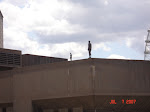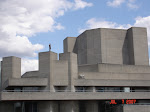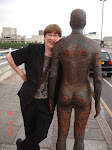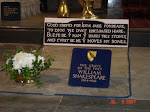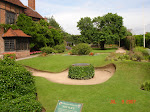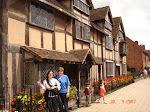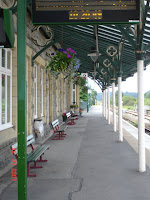Friday, August 3, 2007 Guildhall Library
The Guildhall Library was an interesting facility to visit in that it is a reference, not a lending library, and it focuses mainly, but not exclusively on the history of the City of London. It houses printed books, manuscripts, maps, prints and drawings, and proves very useful to genealogists and other researchers. I really enjoyed going into the bookshop and had a really hard time not spending a lot of money on London maps, London puzzles, and London books. I did buy one book that is full of London trivia, but refrained from buying anything else. This was the last tour that we did as a group.
Thursday, August 2, 2007 Barbican Library
The thing that I will remember most about our trip to the Barbican Library is that John Lake came out to the lobby where we were waiting for the rest of our group and asked us if we had heard about the collapse of the bridge over the Mississippi River and none of us had, so he brought out a piece that he had printed from the Web for us to look at. We were stunned when we saw what had happened.
When we began our tour, we were shown around the marvelous music library that happened to be featuring a display on Punk Rock. One of the groups featured in the display was the 80's punk band The Stranglers, of whom I am a fan. When we were taken back into the music area, there was a man sitting at a piano with headphones who was playing a piece that he had chosen from the library collection. What an exciting way to make use of a public library!
My very favorite part of the whole tour was the children's library, and I loved the picture book section. The books were stored in divided bins on wheels much like the old upright bins that were once used to store phonograph records. The books were down low on the children's level and they would not fall over, or out on the floor when children were looking at them. I want those rolling divided bins in my library.
The services that the children's library provide make it seem like an outstanding facility for children, especially when they provide collections of books for schools that have no libraries of their own in addition to serving the general public. I do think its a shame that schools in the City of London don't have good libraries of their own though. The librarian was also able to explain to us the difference between public, private and council schools. Public schools are schools that anyone with money can attend. Private schools are schools that anyone with money and status can attend, and council schools are publicly funded government schools for everyone else.
When we began our tour, we were shown around the marvelous music library that happened to be featuring a display on Punk Rock. One of the groups featured in the display was the 80's punk band The Stranglers, of whom I am a fan. When we were taken back into the music area, there was a man sitting at a piano with headphones who was playing a piece that he had chosen from the library collection. What an exciting way to make use of a public library!
My very favorite part of the whole tour was the children's library, and I loved the picture book section. The books were stored in divided bins on wheels much like the old upright bins that were once used to store phonograph records. The books were down low on the children's level and they would not fall over, or out on the floor when children were looking at them. I want those rolling divided bins in my library.
The services that the children's library provide make it seem like an outstanding facility for children, especially when they provide collections of books for schools that have no libraries of their own in addition to serving the general public. I do think its a shame that schools in the City of London don't have good libraries of their own though. The librarian was also able to explain to us the difference between public, private and council schools. Public schools are schools that anyone with money can attend. Private schools are schools that anyone with money and status can attend, and council schools are publicly funded government schools for everyone else.
Wednesday, August 1, 2007 National Maritime Museum and Royal Observatory
We took an early boat from Savoy Pier to get to the National Maritime Museum and then went on to the Royal Observatory. Tonya Kirk greeted us at the Caird Library in the National Maritime Museum and gave us a little background before passing us on to the next speakers. The main library is open only to those who are sixteen or older, but any age can do research at E-Library on the computers. The library offers weekend story times to children and there are also some children's books in the E-Library area. When I looked through the collection, I was thrilled to find a copy of Susan Cooper's Victory, a fantasy that steps back in time and features a young man who served with Admiral Lord Nelson on the Victory. It made me wonder if Susan Cooper had actually visited the National Maritime Museum when doing research for Victory.
We got to see several interesting items including an Atlas owned by British pirate Basil Ringrose, Royal Naval Ship The Pearl's log which recounts the capture of Blackbeard, and the merchant log from a slaving vessel whose captain, John Newton, had a religious experience and became anti-slavery and ended up writing the hymn "Amazing Grace." We saw letters signed by Charles II and written by Samuel Pepys, as well as letters from Admiral Lord Nelson to his wife and to his mistress, and quite a few items about the Titanic.
Our afternoon visit to The Royal Observatory was equally impressive, but the thing that I liked most about the whole day was finding a copy of Louise Borden's Sea Clocks in the gift shop at the National Maritime Museum. Louise Borden is a terrific author of children' books who does lots of research and travel to gather primary source materials when she gets an idea for a book. She lives in Terrace Park, (Cincinnati) Ohio and does wonderful presentations for school children. The discovery of her visit to the National Maritime Museum was just as exciting for me as seeing the marker for the Prime Meridian at the Royal Observatory.
We got to see several interesting items including an Atlas owned by British pirate Basil Ringrose, Royal Naval Ship The Pearl's log which recounts the capture of Blackbeard, and the merchant log from a slaving vessel whose captain, John Newton, had a religious experience and became anti-slavery and ended up writing the hymn "Amazing Grace." We saw letters signed by Charles II and written by Samuel Pepys, as well as letters from Admiral Lord Nelson to his wife and to his mistress, and quite a few items about the Titanic.
Our afternoon visit to The Royal Observatory was equally impressive, but the thing that I liked most about the whole day was finding a copy of Louise Borden's Sea Clocks in the gift shop at the National Maritime Museum. Louise Borden is a terrific author of children' books who does lots of research and travel to gather primary source materials when she gets an idea for a book. She lives in Terrace Park, (Cincinnati) Ohio and does wonderful presentations for school children. The discovery of her visit to the National Maritime Museum was just as exciting for me as seeing the marker for the Prime Meridian at the Royal Observatory.
Tuesday, July 31, 2007 Victoria and Albert Museum: National Art Library
Jen and Jenna were our guides at the National Art Library. They showed us some special items in the collection as well as giving us a tour of the stacks area. The art library collects everything from pieces of art to books that are themselves pieces of art or examples of design principles. The book Five Empty Bookcases was just one of the examples of paper engineering that we saw. Drawings in a Nutshell was actually a tiny accordion-fold book whose covers were actual nutshells. Aunt Sally's Lament was another example of paper engineering which started out as quilt designs and ended as a chair.
On the tour, we learned a new term: invigilation. We found that the term describes the supervision of readers when requested items from the collection are brought out for viewing. We got to walk through an invigilation area as we started our tour.
We were also reminded that the art library prefers to do preservation rather than conservation and that there is a preservation and conservation department within the library. If an item is going out on loan to another facility, it is made to look its best before being sent (under security of course). Storage is customized based on the type of item being stored. Phase boxes are custom made for the books that they contain. Dust jackets with ties are used to protect some books, and special red boxes are used to store items that need to be inside an acid free envelope. Special arrangements are made to assure that items which need to lie flat are stored that way.
As with many of the libraries and archives that we have visited, items are arranged by size, shape and acquisition date. Staff members fill reader requests and bring items to the desk where readers pick them up. One thing that I liked about the inquiry or reference desk was that patrons who are physically in front of the desk are dealt with before people who are calling on the phone. I have never understood why it is acceptable for some institutions to make patrons who have waited in line wait even longer when their request is interrupted by a phone caller who is then taken care of first! The books that are stored in the reference section are arranged in Dewey Decimal order and patrons may actually go and pick those off the shelf if they want to use them. Finally, the collection is enlarged in three ways, with purchases, gifts, or exchanges.
On the tour, we learned a new term: invigilation. We found that the term describes the supervision of readers when requested items from the collection are brought out for viewing. We got to walk through an invigilation area as we started our tour.
We were also reminded that the art library prefers to do preservation rather than conservation and that there is a preservation and conservation department within the library. If an item is going out on loan to another facility, it is made to look its best before being sent (under security of course). Storage is customized based on the type of item being stored. Phase boxes are custom made for the books that they contain. Dust jackets with ties are used to protect some books, and special red boxes are used to store items that need to be inside an acid free envelope. Special arrangements are made to assure that items which need to lie flat are stored that way.
As with many of the libraries and archives that we have visited, items are arranged by size, shape and acquisition date. Staff members fill reader requests and bring items to the desk where readers pick them up. One thing that I liked about the inquiry or reference desk was that patrons who are physically in front of the desk are dealt with before people who are calling on the phone. I have never understood why it is acceptable for some institutions to make patrons who have waited in line wait even longer when their request is interrupted by a phone caller who is then taken care of first! The books that are stored in the reference section are arranged in Dewey Decimal order and patrons may actually go and pick those off the shelf if they want to use them. Finally, the collection is enlarged in three ways, with purchases, gifts, or exchanges.
Monday, July 30, 2007 Back to London
The trip back to London started early when Graeme drove me to the train station at Tywyn .
Once I was on the Tywyn-to-Macchynlleth train, it was nice to pass around the Dovey estuary and through Aberdovey and see the boats out in the bay, and the large pastel-painted houses along the cliffs on the other side of the tracks. Aberdovey is where Susan Cooper’s grandmother lived when she was growing up, and where her parents moved when she was 21.
On the way from Macchynlleth to Birmingham, I tried to read Harry Potter and the Deathly Hallows, but I had to stop because I came to the part about Dobbie, and about Fred. First I put on my sunglasses to try to hide the fact that I was crying my eyes out, and then I just had to stop reading because I didn’t have enough tissues with me. Eventually I got out 84 Charing Cross Road and read it. A young woman across the aisle was also reading a copy of it. She told me that her husband had recommended it to her and that it had been on television the previous evening.
On the way from Macchynlleth to Birmingham, I tried to read Harry Potter and the Deathly Hallows, but I had to stop because I came to the part about Dobbie, and about Fred. First I put on my sunglasses to try to hide the fact that I was crying my eyes out, and then I just had to stop reading because I didn’t have enough tissues with me. Eventually I got out 84 Charing Cross Road and read it. A young woman across the aisle was also reading a copy of it. She told me that her husband had recommended it to her and that it had been on television the previous evening.
Sunday, July 27, 2007 Hiking up to Tal y Llyn Lake and back


I took the Sunday morning Tal y Llyn steam train as far north as Abergynolwyn and then started my hike up to Tal y Llyn Lake, which features prominently in Susan Cooper's Grey King. The hike was fairly long and the weather was the warmest that I had experienced while in Wales, but altogether, it was a beautiful day and a terrific hike. Tal y Llyn is considered to be the loveliest lake in Wales, and I would have to agree, and the mountains leading up to and around it are breathtaking as well. I had so many good shots of the lake that it was hard to pick just a couple to show here. The photo to the left is looking off toward Cadir Idris, which is also very significant in The Gray King.
Once I made it to the lake, I had to get back to Abergynolwyn by 2:15 so I could catch the Tal y Llyn Railway back down to Dolgoch Falls, so I headed back after getting all of the photos that I wanted. On the way up, there had been several places where I had to walk right on the road, with no place to get out of the way of cars. On the way back down to Abergynolwyn, I planned on looking for some sort of shortcut that would take me off the worst stretches of the road.
Another oops!
I swear that Graeme's name appeared all on one line when I published the July 26 post!
Subscribe to:
Comments (Atom)
